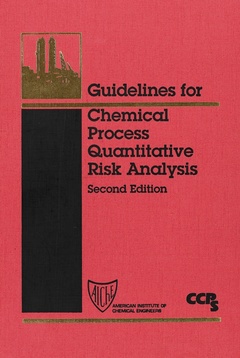Guidelines for Chemical Process Quantitative Risk Analysis (2nd Ed. 2000) (with worked examples in electronic format)

Preface to the First Edition.
Acknowledgments.
Acknowledgments to the First Edition.
Management Overview.
Organization of the Guidelines.
Acronyms.
1. CHEMICAL PROCESS QUANTITATIVE RISK ANALYSIS.
1.1 CPQRA Definitions.
1.2 Component Techniques of CPQRA.
1.2.1 Complete CPQRA Procedure.
1.2.2 Prioritized CPQRA Procedure.
1.3 Scope of CPQRA Studies.
1.3.1 The Study Case.
1.3.2 Typical Goals of CPQRAs.
1.4 Management of Incident Lists.
1.4.1 Enumeration.
1.4.2 Selection.
1.4.3 Tracking.
1.5 Applications of CPQRA.
1.5.1 Screening Techniques.
1.5.2 Applications within Existing Facilities.
1.5.3 Applications within New Projects.
1.6 Limitations of CPQRA.
1.7 Current Practices.
1.8 Utilization of CPQRA Results.
1.9 Project Management.
1.91. Study Goals.
1.9.2 Study Objectives.
1.9.3 Depth of Study.
1.9.4 Special User Requirements.
1.9.5 Construction of a Project Plan.
1.9.6 Project Execution.
1.10 Maintenance of Study Results.
1.11 References.
2. CONSEQUENCE ANALYSIS.
2.1 Source Models.
2.1.1 Discharge Rate Models.
2.1.2 Flash and Evaporation.
2.1.3 Dispersion Models.
2.2 Explosions and Fires.
2.2.1 Vapor Cloud Explosions (VCE).
2.2.2 Flash Fires.
2.2.3 Physical Explosion.
2.2.4 BLEVE and Fireball.
2.2.5 Confined Explosions.
2.2.6 Pool Fries.
2.2.7 Jet Fires.
2.3 Effect Models.
2.3.1 Toxic Gas Effects.
2.3.2 Thermal Effects.
2.3.3 Explosion Effects.
2.4 Evasive Actions.
2.4.1 Background.
2.4.2 Description.
2.4.3 Example Problem.
2.4.4 Discussion.
2.5 Modeling Systems.
2.6 References.
3. EVENT PROBABILITY AND FAILURE FREQUENCY ANALYSIS.
3.1 Incident Frequencies from the Historical Record.
3.1.1 Background.
3.1.2 Description.
3.1.3 Sample Problem.
3.1.4 Discussion.
3.2 Frequency Modeling Techniques.
3.2.2 Event Tree Analysis.
3.3 Complementary Plant Modeling Techniques.
3.3.1 Common Cause Failure Analysis.
3.3.2 Human Reliability Analysis.
3.3.3 External Events Analysis.
3.4 References.
4. MEASUREMENT, CALCULATION, AND PRESENTATION OF RISK ESTIMATES.
4.1 Risk Measures.
4.1.1 Risk Indices.
4.1.2 Individual Risk.
4.1.3 Societal Risk.
4.1.4 Injury Risk Measures.
4.2 Risk Presentation.
4.2.1 Risk Indices.
4.2.2 Individual Risk.
4.2.3 Societal Risk.
4.3 Selection of Risk Measures and Presentation Format.
4.3.1 Selection of Risk Measures.
4.3.2 Selection of Presentation Format.
4.4 Risk Calculations.
4.4.1 Individual Risk.
4.4.2 Societal Risk.
4.4.3 Risk Indices.
4.4.4 General Comments.
4.4.5 Example Risk Calculation Problem.
4.4.6 Sample Problem Illustrating That...
Date de parution : 12-2000
Ouvrage de 754 p.
18x26 cm
